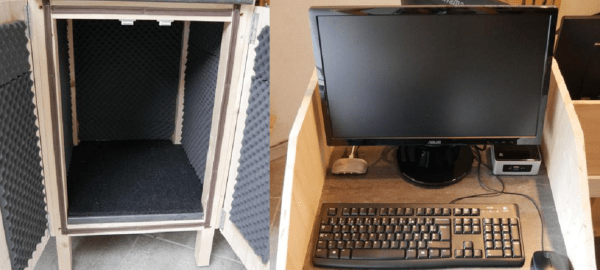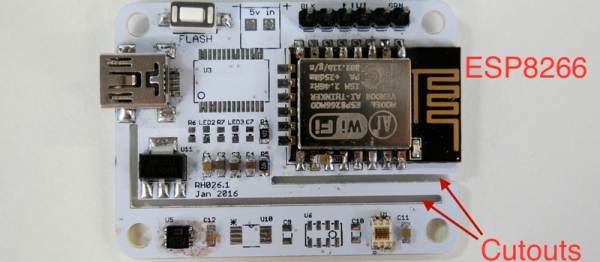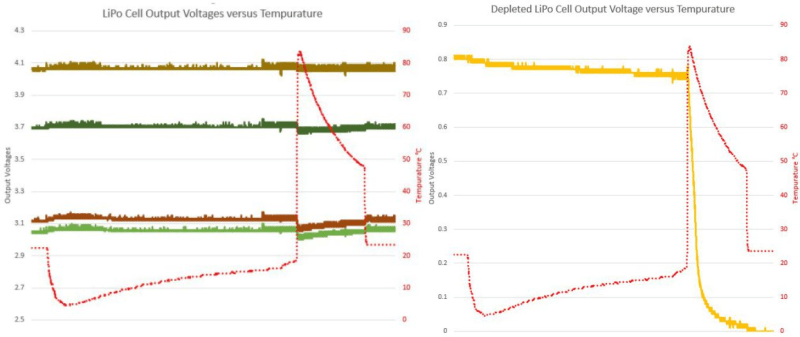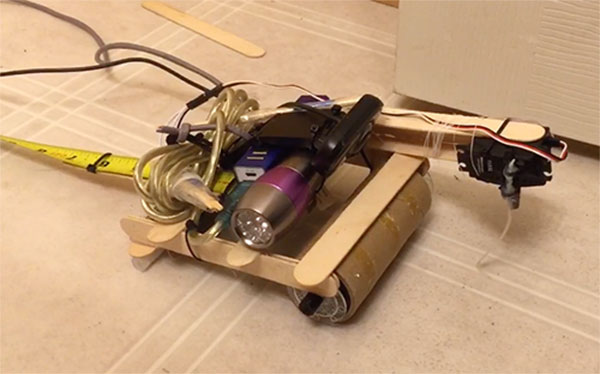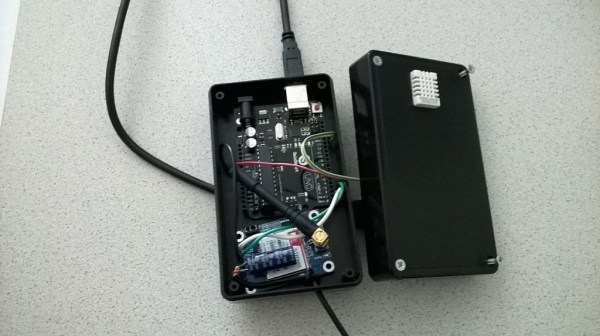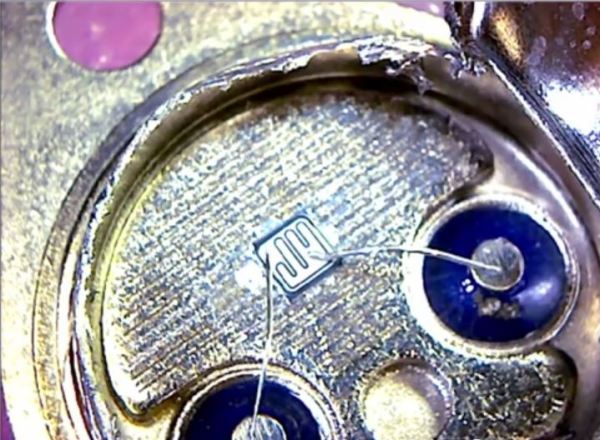heat43 Articles
Fail Of The Week: ESP8266 Heats Temperature Sensor
[Richard Hawthorn] sent us in this interesting fail, complete with an attempted (and yet failed) clever solution. We love learning through other people’s mistakes, so we’re passing it on to you.
First the obvious-in-retrospect fail. [Richard] built a board with a temperature sensor and an ESP8266 module to report the temperature to the Interwebs. If you’ve ever put your finger on an ESP8266 module when it’s really working, you’ll know what went wrong here: the ESP8266 heated up the board and gave a high reading on the temperature sensor.
 Next came the clever bit. [Richard] put cutouts into the board to hopefully stop the flow of heat from the ESP8266 module to the temperature sensor. Again, he found that the board heats up by around four degrees Celcius or nine degrees Farenheit. That’s a horrible result in any units.
Next came the clever bit. [Richard] put cutouts into the board to hopefully stop the flow of heat from the ESP8266 module to the temperature sensor. Again, he found that the board heats up by around four degrees Celcius or nine degrees Farenheit. That’s a horrible result in any units.
What to do? [Richard’s] first ideas are to keep hammering on the thermal isolation, by maybe redoing the board again or adding a heatsink. Maybe a daughterboard for the thermal sensor? We can’t see the board design in enough detail, but we suspect that a flood ground plane may be partly to blame. Try running thin traces only to the temperature section?
[Richard]’s third suggestion is to put the ESP into sleep mode between updates to reduce waste heat and power consumption. He should be doing this anyway, in our opinion, and if it prevents scrapping the boards, so much the better. “Fix it in software!” is the hardware guy’s motto.
But we’ll put the question to you electronics-design backseat drivers loyal Hackaday readers. Have you ever noticed this effect with board-mounted temperature sensors? How did you / would you get around it?
 Fail of the Week is a Hackaday column which celebrates failure as a learning tool. Help keep the fun rolling by writing about your own failures and sending us a link to the story — or sending in links to fail write ups you find in your Internet travels.
Fail of the Week is a Hackaday column which celebrates failure as a learning tool. Help keep the fun rolling by writing about your own failures and sending us a link to the story — or sending in links to fail write ups you find in your Internet travels.
The Mystery Of The Boiled Batteries
While debugging a strange battery failure in a manufacturing process, [Josh] discovered a new (to us) LiPo battery failure mode.
Different battery chemistries react differently to temperature. We’ve used lithium exclusively in high-altitude ballooning, for instance, because of their decent performance when cold. Lithium batteries generally don’t like high temperatures, on the other hand, but besides the risk of bursting into flames, we had no idea that heat could kill them. When the battery’s voltage is already low, though, it turns out it can.
[Josh]’s process required molding plastic with the battery inside, and this meant heating the batteries up. After the fact, he noticed an unreasonably high failure rate in the batteries, and decided to test them out. He put the batteries, each in a different initial charge, into a plastic bag and tortured them all with ice and fire. (OK, boiling water.)
When the batteries got hot, their voltage sagged a little bit, but they recovered afterwards. And while the voltage sagged a little bit more for the batteries with lower initial charge, that’s nothing compared to the complete failure of the battery that entered the hot water with under 1V on it — see they yellow line in the graphs.
There’s a million ways to kill a battery, and lithium batteries are known not to like being completely discharged, but it looks like the combination of deep discharge and heat is entirely deadly. Now you know.
Heat Duct Rover Explores Stink, Rescues Flashlight
It all started with a bad smell coming from the heat register. [CuddleBurrito] recalled a time when something stinky ended up in the ductwork of his folks’ house which ended up costing them big bucks to explore. The hacker mindset shies away from those expenditures and toward literally rolling your own solution to investigating the funk. In the process [CuddleBurrito] takes us on a journey into the bowels of his house.
Continue reading “Heat Duct Rover Explores Stink, Rescues Flashlight”
Too Hot For Fido? Get Alerted!
Meet project Oro, the temperature monitoring watchdog. Err… the watchdog monitoring temperature probe. Well, it’s both actually!
[Richard Deininger] built the project after having the AC system go down in his company’s server room. That environmental cooling is imperative if you don’t want your server hardware turned to slag. The idea is a separate piece of hardware that monitors the room temperature and will alert the on-call staff if it climbs too high. He was successful, and showing the hacked hardware around the office came up with a second idea: a temperature sensor for your car to ensure it’s not too hot for your dog.
Anyone who has a canine friend living with them knows you don’t utter the word “ride” out loud lest a barking, whimpering, whining frenzy ensue. But jingle those keys and they’ll be at the door in no time. During the summer you can still take them with you for short errands thanks to the peace of mind [Richard’s] build provides. It’s simply an Arduino, DHT22 temp/humidity probe, and a SIM900 GSM modem. Set your temperature threshold and you’ll get an alert if temperatures are climbing to unsafe levels for Fido.
While you have your tools out, we recommend building auto-watering and auto-feeding systems for the family pets. What’s that? You hate domesticated animals? There’s a hack you can use to chase them from your yard.
Hot Or Not? Find Out How To Calculate Component Heat And Why You Should
How hot are your key components getting? There’s a good chance you’ve built a project and thought: “Well I guess I better slap a heat sink in there to be safe”. But when working on a more refined build you really need to calculate heat dissipation to ensure reliability. This is actually not tough at all. The numbers are right there in the datasheet. Yes, that datasheet packed with number, figures, tables, graphs, slogans, marketing statements, order numbers… you know right where to look, don’t you?
Hackaday has you covered on this one. In under 10 minutes [Bil Herd] will not only show how easy these calculations are, he’ll tell you where to look in the datasheets to get the info you need quickly.
Continue reading “Hot Or Not? Find Out How To Calculate Component Heat And Why You Should”
Hacking A Heating Pad
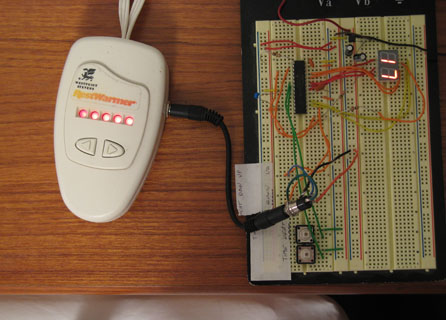
[Bob] and his wife use a bed heating pad. In the winter, they typically turn it on about an hour before bedtime so the bed is nice and warm. The problem is, if they accidentally leave it on, they’ll wake up a few hours later: overheated. What they needed was an advanced timer system.
A normal outlet timer wouldn’t fit his needs: most of the year the pad should shut off after a slight delay, but in the winter they prefer to leave the heating pad on at a much lower temperature. [Bob] decided to create a custom timer with a microcontroller to provide adjustable duration and heating levels.
The circuit is simple. It consists of a microcontroller, a 2-digit LED display, two buttons, and two wires that connect to the heating pad’s original controller. The final build allows you to set the time the pad turns on, turns off, and/or down a few levels. It’s a fantastic hack, and you can see how the interface works in the video following the break.

